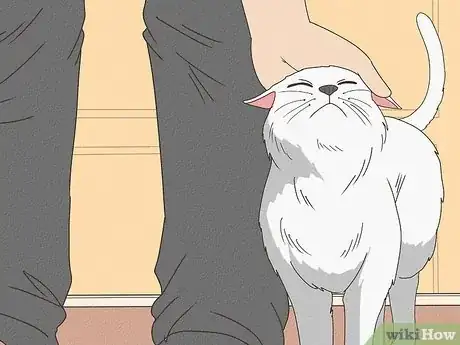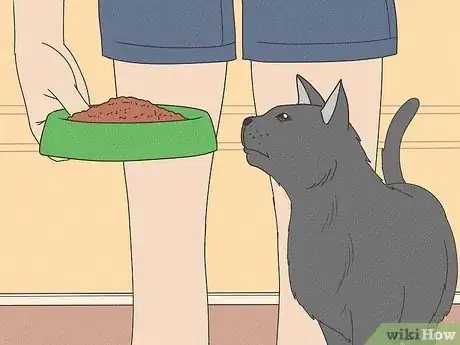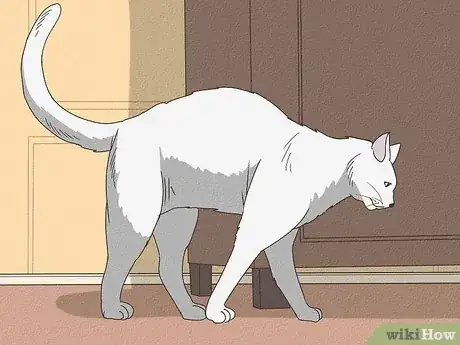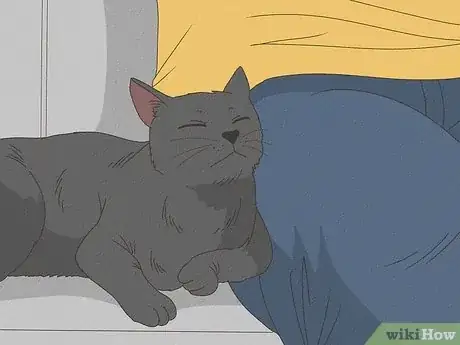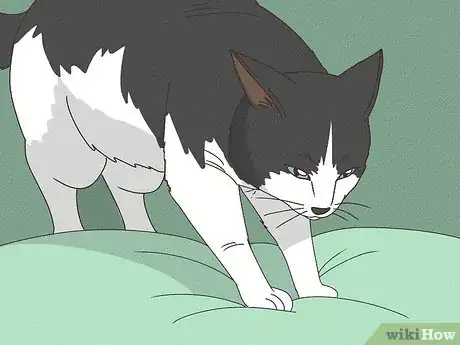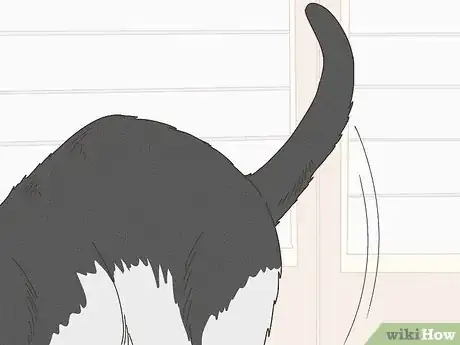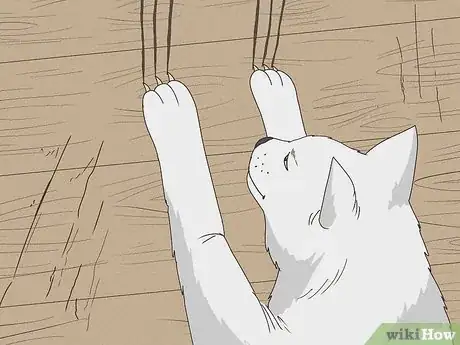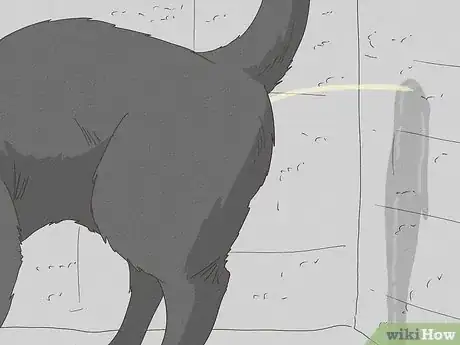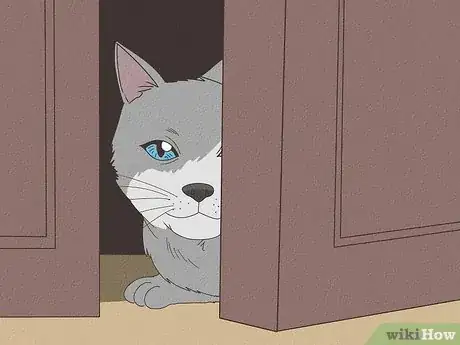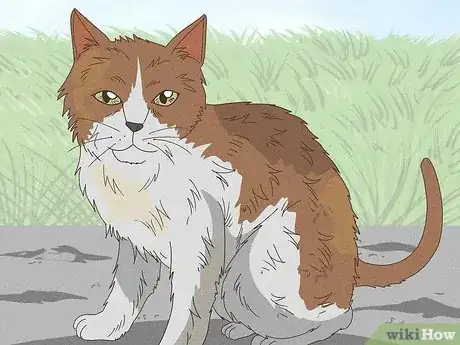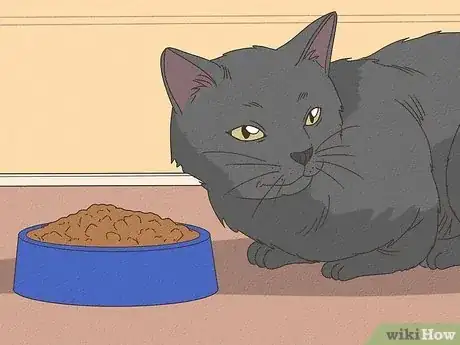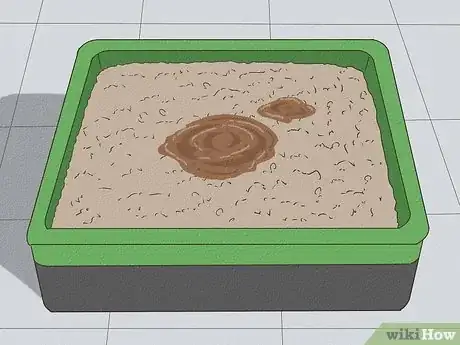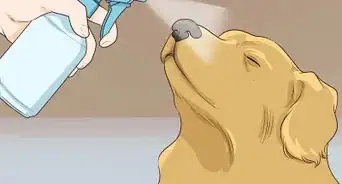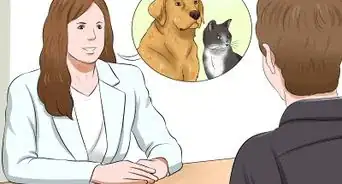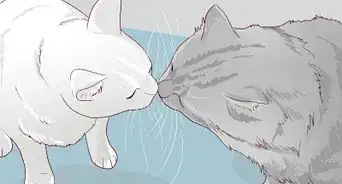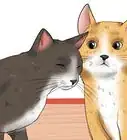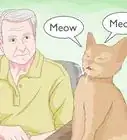This article was co-authored by Molly DeVoss and by wikiHow staff writer, Luke Smith, MFA. Molly DeVoss is a Certified Feline Training and Behavior Specialist (CFTBS), a Certified Cat Behavior Consultant (CCBC), a Fear Free Certified Trainer (FFCT), and the Founder of Cat Behavior Solutions. Molly specializes in using positive reinforcement to modify and prevent unwanted behaviors in cats and reduce cat shelter surrender. Molly has sat on the Dallas Animal Advisory committee since 2013 and was voted one of the Top 12 Extraordinary Cat Behaviorists of 2020 by Catpetclub.com. She is certified by both the Animal Behavior Institute and the International Association of Animal Behavior Consultants. She is also the host of the weekly podcast Cat Talk Radio.
There are 7 references cited in this article, which can be found at the bottom of the page.
Cats have plenty of funny behaviors, and one of our favorites is the endearing face rub. Our feline friends often rub up against anything from furniture to ourselves, or even other pets. They do this primarily to spread pheromones produced by glands that are located all over their bodies, and which other cats can “read” to get a huge amount of information. But these pheromones can mean a number of things, from affection to territorial marking.[1] We’ll explain why cats rub against you, what their other common behaviors mean, and even explain what behaviors need to get checked out by a vet.
Things You Should Know
- Cats rub against you as a greeting, and also as a way to “claim you” as part of their family.
- Cats also rub against you to ask for something, or to mark their territory.
- Other ways cats communicate include meowing, urinating, scratching, tail flicking, and kneading.
- If you observe behaviors that aren’t as common, like hiding or lack of grooming, it could be time for a vet visit.
Steps
Reasons Cats Rub Against You
-
1To show affection When a cat rubs against you by butting its head into your body, it’s called “bunting” and is a sign of affection. Cats do this to people and other cats to tell them that they feel comfortable in their presence—it’s like the cat equivalent of a hug! Bunting is often accompanied by purring.[2]
- Reciprocate your cat’s affection by giving them a gentle rub or scratch around the ears or on the cheeks.[3] Alternatively, play with your cat to acknowledge them and provide enrichment.
- Cats also bunt other cats to establish or reinforce a hierarchy. Cats higher up the ladder tend to bunt other cats more often.
-
2To leave their scent on you Cats like to feel comfortable in their home, and they’re most at ease when surrounded by their familiar pheromones. To maintain those pheromones, cats might come to say “Hello” by rubbing up against you when you come home or enter a room. This is a way to create a “group scent” and welcome you into their feline family.[4]Advertisement
-
3To ask for things Cats often rub against their people when they want something. They might be reminding you that it’s time for a meal, or just begging for a treat. Cats also do this when they want you to pay attention to them.[5]
-
4To assert themselves If you live with multiple cats, you might see that they’re constantly rubbing up against everything from doorways to furniture to anyone in your home. This might be a silent form of conflict between the cats themselves, in which the cats mark things around the home to solidify their territory and presence around other cats. It can be their way of saying, “This is my house, too.”[6]
- You can reduce conflict between cats by providing the cats each with their own resources like litter boxes, water and food dishes, beds, etc. You can also spay and neuter cats to cut down on aggressive behaviors.
-
5Because they’re in heat Female cats that aren’t spayed enter heat every 18 to 24 days, and during this time they may display signs that tell other cats that they’re on the market. These signs include increased purring, meowing, rolling on the floor, and—yes—rubbing their faces all over you.[7]
Other Common Cat Behaviors
-
1Meowing Everyone’s favorite sound, cats meow for a wide range of reasons: to greet you, get your attention, ask for things, express disorientation, or to find a mate. Some cats love to vocalize, but if your cat seems to be meowing or yowling more than usual, it might be time to consult a vet—your cat might be trying to tell you something’s wrong.[8]
-
2Kneading A cat will “knead” or “make biscuits” by pushing its paws into a soft surface like a cushion or your stomach. This is a leftover habit from when the cat was a kitten, when it would knead its mother’s belly to stimulate milk flow. When adult cats do it, it means they’re happy and content.[9] Of course, it also means they’re a little baker with little biscuits to bake, but that’s a less scientific explanation.
-
3Tail movements Cats’ tails are also useful vehicles for expression. An upright tail with flattened fur indicates alertness and contentedness, but if the fur is on-end it means your cat is agitated. A thrashing tail is a sign of an angry or frustrated cat, while a tucked tail means an anxious cat. Finally, a straight-up, quivering tail makes for an extremely happy or excited cat—either that, or they’re getting ready to spray something.[10]
-
4Scratching Cats might scratch in order to leave a visual marker of their territory, but there are many other, practical reasons as well. These include keeping their nails in check, stretching their back and shoulder muscles, releasing frustration, or displaying pleasure.[11]
- Though a scratching cat can be irksome or even painful, don’t look to declawing as a solution. Declawing can cause a cat to become stressed or chronically frustrated. Instead, try to stop a cat from scratching things you don't want them to ruin by teaching your cat to use a scratching post.
-
5Peeing Like dogs, cats also mark their territory by urinating. They might mark entire locations or just certain objects to assert themselves over other cats, or even other pets or people in the home. This can be averted with added enrichment like toys or climbing structures, or by teaching your pets and people to respect a cat’s boundaries—keep excitable or aggressive dogs separate from cats, and teach young children to leave sensitive cats be.[12]
Behaviors to Get Checked Out by a Vet
-
1Withdrawn behavior Though rubbing may not be a sign of illness, be on the lookout for other behaviors that might indicate that something is wrong with your cat. If your cat has uncharacteristically low energy levels or is withdrawing or hiding more than usual, it could be time to take your cat to a veterinarian.[13]
-
2Unkempt appearance Cats like to look and feel clean, and a healthy cat will groom itself regularly. Your cat may be ill or agitated, however, if it has a greasy coat, matted or loose fur, or excess dandruff. These are indicators that your cat may not be grooming itself properly as a result of sickness.[14]
- Agitated cats may also groom themselves excessively, which might be a sign of a skin problem or allergies.
-
3Unusual appetite Your cat likes to keep a fairly regular eating schedule, and so if your cat suddenly refuses to eat or overeats, it could be cause for concern. In addition, too much drinking can indicate a metabolic problem, and too little hydration might point to diabetes or other diseases.[15]
-
4Diarrhea or irregular cat waste Your cat’s illness might show up in its litter box. Diarrhea is a clear indicator of disease or other metabolic issues. On the other hand, constipation is more difficult to notice, but a lack of waste—or else too-small or dry stools—might be a sign of kidney disease. Increased or decreased amounts of urine are also signs of trouble, so consult your vet as soon as possible if you notice any of these signs while cleaning your cat’s litter box.[16]
References
- ↑ https://abandonedpetrescue.org/the-ritual-of-affection-why-do-cats-rub-against-you/
- ↑ https://catonsvillecatclinic.com/holmes-corner/why-does-my-cat-rub-againsteverything/
- ↑ https://abandonedpetrescue.org/the-ritual-of-affection-why-do-cats-rub-against-you/
- ↑ https://abandonedpetrescue.org/the-ritual-of-affection-why-do-cats-rub-against-you/
- ↑ https://catonsvillecatclinic.com/holmes-corner/why-does-my-cat-rub-againsteverything/
- ↑ https://indoorpet.osu.edu/cats/problemsolving/conflict
- ↑ https://www.aspca.org/pet-care/cat-care/common-cat-behavior-issues/meowing-and-yowling
- ↑ https://www.aspca.org/pet-care/cat-care/common-cat-behavior-issues/meowing-and-yowling
- ↑ https://www.humanesociety.org/resources/cats-meow
- ↑ https://www.humanesociety.org/resources/cats-meow
- ↑ https://www.animalhumanesociety.org/behavior/managing-scratching-behavior-cats
- ↑ https://indoorpet.osu.edu/cats/problemsolving/conflict
- ↑ https://vcahospitals.com/know-your-pet/recognizing-signs-of-illness-in-cats
- ↑ https://vcahospitals.com/know-your-pet/recognizing-signs-of-illness-in-cats
- ↑ https://vcahospitals.com/know-your-pet/recognizing-signs-of-illness-in-cats
- ↑ https://vcahospitals.com/know-your-pet/recognizing-signs-of-illness-in-cats
